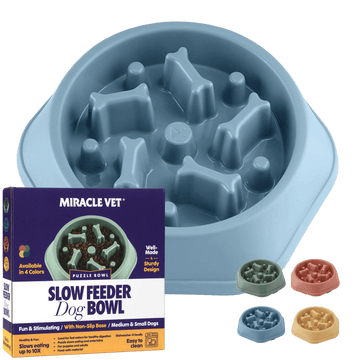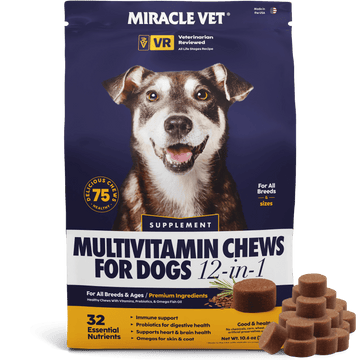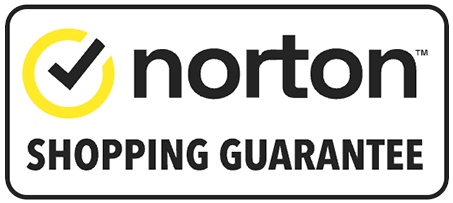But feeding your dog isn’t always as simple as it seems.
A lot of people get confused about how to feed your dog. How much food? How often? How do you transition to a new food?
So to help you out, we put together this list of frequently asked questions about how to best feed your dog.
1: How much food should you give your dog?
The important thing to realize is that every dog food is different. Depending on the ingredients, some will contain more calories per serving than others.
The best advice is to follow the instructions on the label to start.
When you make the switch to all-natural Miracle Vet Dog Food, for example, we tell you right there on the label how much food to give your dog based on their weight.
From there, make adjustments based on how your dog reacts. If you find that your starts gaining or losing weight, then increase or decrease the amount of food you give them.
Finally, keep in mind that your dog’s age plays a role in how much food they need. Adult dogs typically require more food than puppies and seniors.
2: When is my puppy considered an adult dog?
The answer depends on the size of your dog.
Large breeds are considered adults at 1-2 years old.
Small and medium breeds are considered adults at 6 months old.
3: When is my dog considered a senior dog?
Once again, the answer depends on the size of your dog.
Large breeds reach senior status around 2-5 years old. (Depending on the specific breed.)
Small and medium breeds reach senior status around 7 years old.
4: Is it true that senior dogs should eat less protein?
No—that’s a myth. All healthy dogs should eat a meat-based food (a real meat should be the #1 ingredient) with plenty of protein.
Senior dogs often don’t need to eat as many calories. But the percentage of protein in their dig should be the same as it is for adult dogs.
5: What type of dog food do you recommend for puppies/seniors?
Some companies produce foods that are supposedly made for puppies or seniors specifically.
This is not necessary.
We recommend choosing a type of dog food that is meant for “All Life Stages.” This means the food is sufficient for puppies, adults, and seniors.
The only difference is that you’ll want to decrease the amount of food you give to seniors and puppies to account for their decreased calorie requirements.
6: What’s the best way to switch to a new dog food?
Anytime you plan to change your dog’s food, you shouldn’t do it all once. That could lead to GI problems like diarrhea and upset stomach.
Instead, it’s best to gradually transitioning to your dog’s new food.
We recommend starting out with about ¼ new food. So if you feed your dog 1 cup, start with ¾ cup of the old food and ¼ cup of the new food.
Then slowly increase the new food over the course of a week or so until they are no longer eating any of the old food.
7: I switched to a new type of food, and my dog had issues like gas and diarrhea. What’s going on there?
First, make sure you are giving your dog a slow transition to the new food (see the previous question).
If that doesn’t help, then there is probably something in the food that doesn’t agree with your dog’s system. They may have an allergy or a dietary intolerance to some of the ingredients.
When that happens, the best thing is probably to stop using the food. The symptoms should go away when you go back to the old food. If they don’t, it’s probably best to talk to your vet.
8: Can I feed my dog table food?
It really depends on the food. Many people feed their dog “table scraps,” which often contains the fatty trimmings from meat. This might seem like a perfectly healthy thing to feed your dog...but it’s not.
It has a much higher concentration of fat than your dog should eat.
On the other hand, giving your dog a little bit of high-quality meat (such as a good bite of chicken or salmon) is fine. Just be aware that feeding your dog from the table is liable to encourage the bad habit of begging for food anytime you sit down for dinner.
9: Should I feed my dog canned food, dry food, or both?
In general, there’s no “best” kind of dog food. Each kind has its own pros and cons.
A great benefit of wet dog food is that it has a higher moisture content, which helps to keep your dog hydrated. Wet food also tends to have fewer carbohydrates.
The downside of wet food is that it’s more expensive and less convenient for you. It has to be refrigerated after opening, and doesn’t last long once it’s been exposed to the air. You can’t leave wet food in the dog bowl too long or it can go bad. Wet food is also more expensive.
Dry food, on the other hand, is cheaper and much more convenient for you, the owner. You can fill your dog’s bowl and keep it there, out in the open, for several days with no ill effects.
One downside with dry food is that it’s easier for unscrupulous manufacturers to sneak in low-quality ingredients like corn, soy, wheat, and so on. So if you want the benefits of dry food while still feeding your dog the healthiest diet around, make sure to choose a top-shelf brand like Miracle Vet.
10: What’s the best way to store dry dog food?
As we just mentioned, one of the big benefits of dry food is that it stays good for a long time.
But it doesn’t stay good forever.
Make sure to check the “Best By” date on your food and plan to use it before that date. And it’s also important to realize that your food will only last that long if it’s stored in a cool, dry place.
In general, air and moisture will will make your food go bad faster. So keep your dog food somewhere cool, dry, and dark. Squeeze out the air before you seal it shut to minimize the air inside.
Some owners prefer to buy a resealable container. If you want to do that, go ahead. But don’t take the food out of its original container. Instead, put the original container inside the resealable container. This is the best way to store your food.
Have any more questions about feeding your dog?
If you have any questions we didn’t address in this article, leave a comment below. We’ll make sure to get you the answer to your questions!









